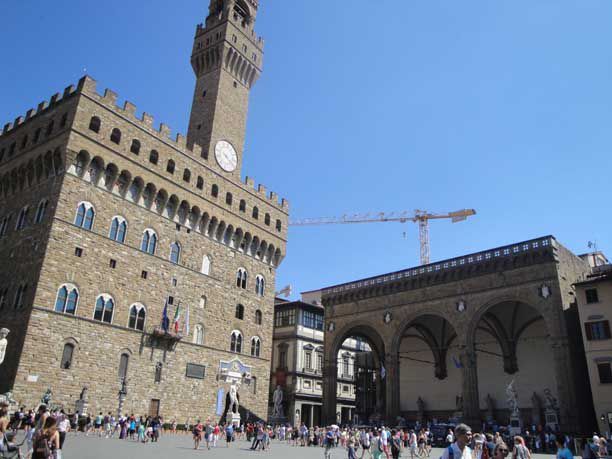The Piazza della Signoria has always been the focal point of the history of the Florentine Republic. It serves a public function, particularly by housing the Loggia dei Lanzi (lodge for public gatherings).
The square is dominated by the Palazzo Vecchio (town hall) and its tower of Arnolfo. It was important in Roman times, as evidenced by its thermal baths and theater, whose remains were found buried in the Palazzo Vecchio.
In medieval times, two small churches and several tower-houses were situated in the square, including the tower-houses of the Uberti, a Ghibelline family to whom belonged Farinata.
While Dante condemned Farinata as a heretic, he nevertheless exalted him as the savior of Florence for opposing the victorious Ghibellines’ proposal to destroy the city.
In 1268, the houses of the Ghibellines that were located in the square were razed to the ground by the Guelphs, who were recently victorious in the Battle of Benevento. The square was finally paved in 1385.
Construction of the Palazzo Vecchio began on February 24, 1299, on the spot where stood the houses of the Foraboschi, near the church of San Pier Scheraggio.
Please visit our post on the Palazzo Vecchio for further details. However, it is noteworthy that when he decided to leave the palace, Cosimo I thought about prolonging the Loggia dei Lanzi so as to surround the Piazza della Signoria, but changed his mind on account of elevated construction costs.
Between 1560 and 1575, Bartolomeo Ammannati built the famous Neptune Fountain. The layout of this fountain was based on a drawing by Leonardo da Vinci.
However, the ironic Florentines mocked the statue, calling it “Biancone” (the white giant). In fact, at the inauguration of the statue in 1565, the people of Florence famously yelled “Ammannati, Ammannati, what a beautiful marble you’ve ruined!”
Near the fountain, on the floor of the square, a marble slab commemorates the place where Savonarola was executed in 1498.
In 1594, the equestrian statue of Cosimo I by Giambologna was erected.
Among the other buildings that surround the square are the following: the palace of the Court of Merchandise (1358), situated to the left of the Palazzo Vecchio this institute, founded in 1308, served to resolve disputes between the different guilds or between members of the same guild; and the Uguccioni sixteenth-century palace, located in front of the Loggia dei Lanzi.
The ancient church of Santa Cecilia was once located right in front of the Palazzo Vecchio.
In 1871, the Palazzo delle Assicurazioni Generali was designed. The famous Caffé Rivoire is located today on the ground floor.
Today, the Piazza della Signoria is the home of many festivals, such as the festival of the patron San Giovanni (celebrated by fireworks), the Giostra del Saracino, and many important weddings.
Another special festival is Fiorita, which occurs every year on May 23 to commemorate the death of Savonarola. After the celebration of mass in the Palazzo Vecchio, the Dominicans, the municipal authorities and citizens went into the streets to spread flower petals on the exact spot where Savonarola was hanged and burned.
The ceremony comes from the fact that the place of execution was found covered with flowers on the very next day.










